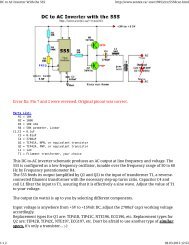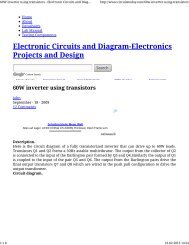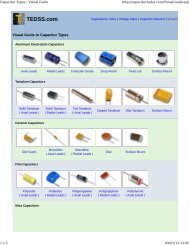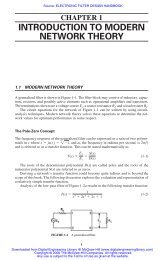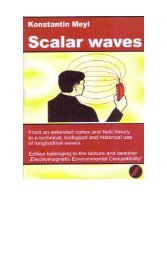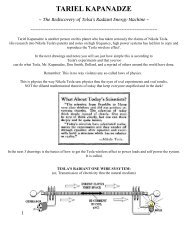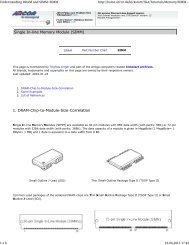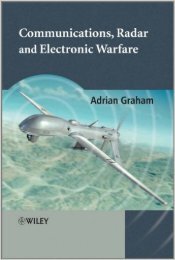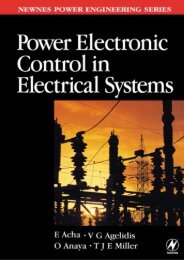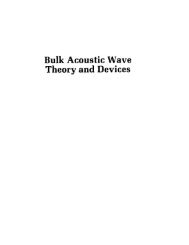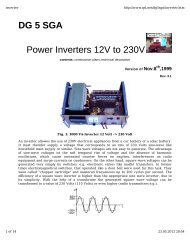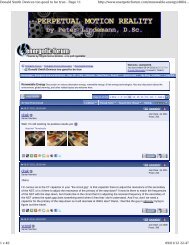New Energy Technologies Magazine nr 3 2005.pdf - Index of
New Energy Technologies Magazine nr 3 2005.pdf - Index of
New Energy Technologies Magazine nr 3 2005.pdf - Index of
You also want an ePaper? Increase the reach of your titles
YUMPU automatically turns print PDFs into web optimized ePapers that Google loves.
antedated Feynman by over 60 years!<br />
Feynman called the three particles making<br />
up the proton quarks.<br />
The gravitation constant as grad E correlates<br />
with the seminal work by T. Townsend Brown.<br />
Brown discovered that a capacitor will tend to<br />
move in the direction <strong>of</strong> the positive plate.<br />
Apparent weight loss is the result when the<br />
plates are perpendicular to the local gravity<br />
gradient. This effect can be enhanced by making<br />
one plate much smaller than the other plate.<br />
This essentially forces the grad E to maximize.<br />
It should be noted that grad E is independent<br />
<strong>of</strong> whether the field is AC or DC. Experiments<br />
have shown that even with this enhancement<br />
the capacitor does not have all its apparent<br />
weight nullified and levitate.<br />
(The editor's note: Our researches have<br />
shown that gradient E produced due to the<br />
properties <strong>of</strong> the dielectric's material is a more<br />
perspective method. A. Frolov)<br />
The reason for this can be found again in the<br />
nuclear particle's relationship with the aether.<br />
Even though each atom is in constant resonance<br />
with the aether this resonance is not<br />
synchronized across the mass4. Each atom is<br />
doing its own thing, so to speak, and there is a<br />
random interchange with the aether with<br />
respect to all the nuclei.<br />
Thus, when a grad E acts as an aether pump<br />
across the capacitor plates only a small portion<br />
<strong>of</strong> the atoms become synchronized to this<br />
aetheric flow so the entire mass does not<br />
respond at the same time; therefore, all the<br />
atoms don't try and move at the same time.<br />
The Detection <strong>of</strong> Aetheric Gravity Flow<br />
Using Dielectrics<br />
It should be obvious that the larger the mass<br />
the more aether which flows into the atomic<br />
structure <strong>of</strong> the mass. Mass is both radiating<br />
and absorbing aetheric energy.<br />
Other mass in the vicinity will cause<br />
perturbations in this aetheric flow. Because <strong>of</strong><br />
this fact, aetheric flow detectors can be<br />
constructed by taking advantage <strong>of</strong> this<br />
principle.<br />
Davidson's first working gravity or local<br />
aetheric stress/flow detector was<br />
demonstrated at the 1990 Extraordinary<br />
Science Conference in Colorado Springs,<br />
Colorado. The basic principle <strong>of</strong> the gravity<br />
detector is the fact that the electronic charge<br />
structure <strong>of</strong> a given mass is a function <strong>of</strong> the<br />
amount <strong>of</strong> aether flowing into the mass. The<br />
charge around the atom is governed by the<br />
amount <strong>of</strong> aether flowing into and out <strong>of</strong> the<br />
mass. His reasoning was that dielectrics would<br />
make the best aetheric flow detector. In<br />
dielectrics the electronic charge is isolated and<br />
trapped within the dielectric material since the<br />
charge cannot flow and dissipate. By using a<br />
high dielectric such as titanate zirconate or<br />
barium titanate the amount <strong>of</strong> charge change<br />
is directly readable by putting electrodes on<br />
each pole <strong>of</strong> a polarized dielectric.<br />
Davidson's first detector circuit used a<br />
picoamplifier attached to the electrodes to<br />
amplify the signal. Then the voltage/current<br />
Analysis <strong>of</strong> various apparently disconnected<br />
events where levitation was witnessed provides<br />
some important clues to a means <strong>of</strong> effecting<br />
synchronization <strong>of</strong> the nuclei.<br />
Synchronization <strong>of</strong> the nuclei with the aether<br />
has been achieved by two main methods;<br />
namely, rotation or movement and sonically.<br />
Analysis <strong>of</strong> the phenomenon <strong>of</strong> inertia provides<br />
the major clue to how rotation could act to<br />
synchronize the flow <strong>of</strong> aether into the nuclear<br />
sub structure <strong>of</strong> the gravitors.<br />
Fig. 4. Gravity Sensor Data Example.<br />
Data from July 11, 1991 Solar Eclipse<br />
46 <strong>New</strong> <strong>Energy</strong> <strong>Technologies</strong> #3(22) 2005



